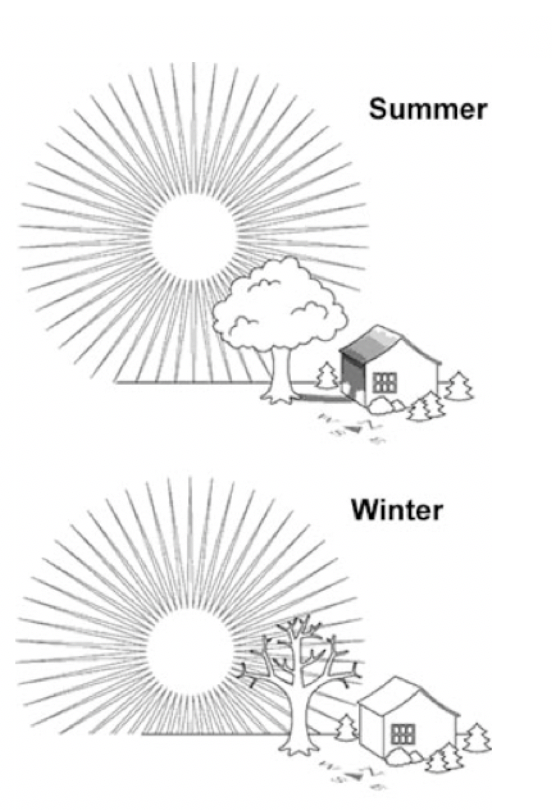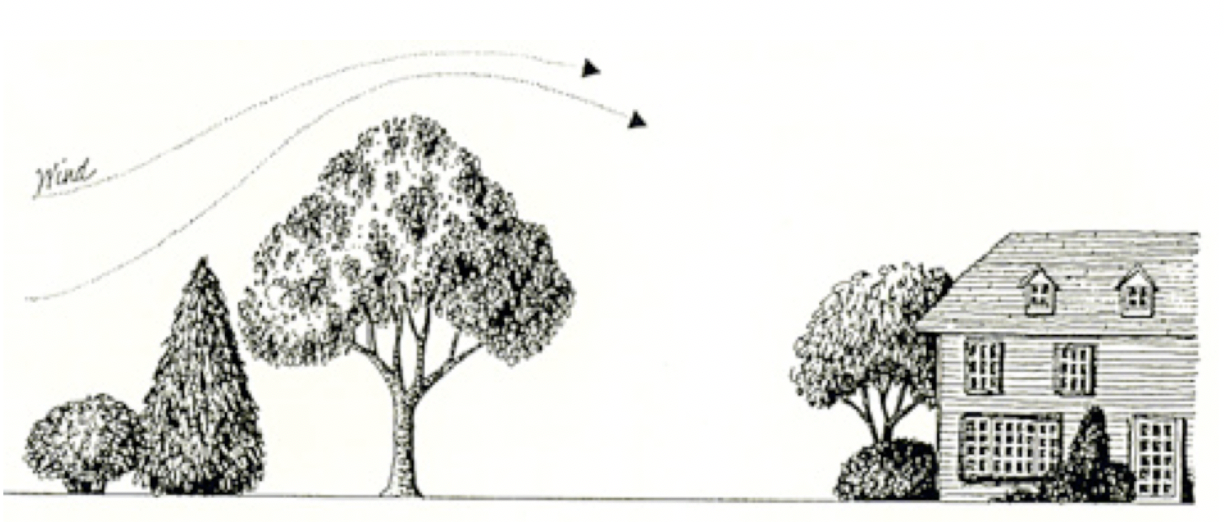Energy-Efficient Landscaping
New ResidentialWhat is Energy-Efficient Landscaping?
Energy-efficient landscaping reduces a household’s energy consumption through the strategic placement of trees, shrubs, and plants (see Tree Protection and Placement).
Heating and cooling comprise nearly half of a household’s energy consumption.[1] Energy-efficient landscaping provides a low-cost solution to reducing energy use with both economic and environmental benefits.
Heat exchange occurs in three processes: air infiltration,[2] conduction,[3] solar-radiation.[4] Energy-efficient landscaping uses four main strategies to moderate these processes.
- Plant trees and shrubs to provide shade and reduce solar heat gain in the summer (see Glare and Heat Gain Reduction).
- Plant trees and shrubs to prevent heat loss in the winter.
- Plant trees and shrubs to deflect winter winds and maintain a warmer microclimate around the building.
- Consider a vegetated roof to provide extra thermal mass and insulation (see Vegetated Roof).
How to Implement an Energy-Efficient Landscape
When designing an energy-efficient landscape consider New Jersey’s temperate climate and your property’s unique micro-climate. Before construction begins, consult with an International Society for Arboriculture (ISA) certified arborist who can work with the project team to formulate a plan to protect existing trees (see Tree Protection and Placement). When possible, protect or enhance the diversity of native species and age of trees on the site and maintain them as necessary (see Native and Adapted Plants).

Figure 1: Tree placement for energy-efficiency (Source: The Morton Arboretum)
The following table is a guide to help achieve energy efficiency.
Table 1: Goals and Appropriate Landscape Types[5]

(Source: Adapted from US DOE Landscaping for Energy-Efficient Homes)
Tips and Maintenance

Figure 2 – Windbreak (Source: Virginia Cooperative Extension)
- Consider mapping the sun’s path to understand the site’s microclimate better.
- Create a landscape and maintenance plan.
- Do not plant trees too close to the house because roots may grow into the foundation. Place medium to large trees at least 20 feet from the house. Place trees that result in small, full-grown crowns closer to the house to maintain both energy and aesthetic value. See the Arbor Day Tree Guide for growth rate and crown size information for specific tree species.
- Review the Native and Adapted Plants strategy for plant selection guidance. Consider genetic diversity to minimize potential disease and insect problems.
- Consider using temporary measures to provide shade until trees reach maturity. For instance, vines growing on a trellis can shade air conditioning units. If using mature trees for shading or a windbreak, plant a temporary row of faster-growing shrubs upwind of the permanent row and remove before the roots interfere with the permanent planting.
Benefits
- According to a Lawrence Berkeley National Labs study, landscapes that provided shade result in temperatures 3-6°F cooler can decrease the energy load required for buildings by 9-20%.
- Shading an air conditioning unit can increase its efficiency by up to 10% and allow units to operate more efficiently.[6]
- Windbreaks can save up to 25% on heating costs by protecting the microclimate surrounding a building.[7]
- Decreasing energy demand to heat and cool buildings also reduces carbon dioxide emissions from energy generation.
Costs
Moderate upfront investments in energy-efficient landscaping can realize paybacks in as little as eight years as trees and shrubs reach full maturity, offering maximum energy-saving benefits.[8] Large, deep-rooted deciduous trees provide optimal shading benefits but depending on growth rate of the species, may take up to 5 or 10 years to reach full maturity.
Resiliency
Energy efficient landscaping offers a strong line of natural defense for buildings and the surrounding community. Instead of implementing costly, time-consuming engineering projects, natural systems such as trees for windbreaks or shade, and wetlands for storm barriers offer protection from the elements, along with substantial energy savings. In the event of a significant heat wave, shade-providing trees help to reduce the urban heat island effect, reduce indoor cooling loads, and reduce stress on the power grid. When emergency events disrupt regular supply and delivery networks, fruit producing trees can supplement local food supplies. Furthermore, properly sited and maintained trees can block buildings from severe winds and offer protection from extreme cold.
Note that debris from storm-related tree damage and downed electric lines caused by wind, snow, and ice, flooding and lightning result in one of the most substantial storm-related expenses. Maintaining tree health through proper pruning, watering, and disease control can help prevent tree damage and preserve the many benefits of trees.
[1] US EIA. 2003. Commercial Building Energy Consumption Survey, Table E1A. https://www.eia.gov/consumption/commercial/data/2003/pdf/e1a-e11a.pdf (accessed April 10, 2018).
[2] Air infiltration occurs when outside air enters a house uncontrollably through cracks and openings. https://www.energy.gov/energysaver/weatherize/air-sealing-your-home (accessed April 10, 2018).
[3]Conduction is heat traveling through a solid material https://www.energy.gov/energysaver/principles-heating-and-cooling (accessed April 10, 2018)
[4] Solar radiation is heat created from sunlight https://www.energy.gov/eere/solar/articles/solar-radiation-basics (accessed April 10, 2018).
[5] US DOE. Energy-Efficient Landscaping for Homes https://www.energy.gov/energysaver/design/landscaping-energy-efficient-homes (accessed April 10, 2018).
[6] US DOE. Landscaping for Shade. https://www.energy.gov/energysaver/landscaping-energy-efficient-homes/landscaping-shade (April 10, 2018).
[7] Walker, L. and Newman, S. Landscaping for Energy Conservation. Colorado State University Extension Publications. no.7.225. March 2009. http://extension.colostate.edu/topic-areas/yard-garden/landscaping-for-energy-conservation-7-225/ (accessed April 10, 2018).
[8] US DOE. Landscaping for Shade. https://www.energy.gov/energysaver/landscaping-energy-efficient-homes/landscaping-shade (April 10, 2018).
Resources
- American Society of Landscape Architects (ASLA) – Resilient Design
- International Society of Arboriculture
- Landscape for Life
- National Arbor Day Foundation
- Native Plant Society of New Jersey
- New Jersey Master Gardeners
- Rutgers New Jersey Agricultural Experiment Station
- The Sustainable Sites Initiative
- Sustainable Sources: Landscaping for Energy Savings
- US DOE: Energy Savers – Landscaping
